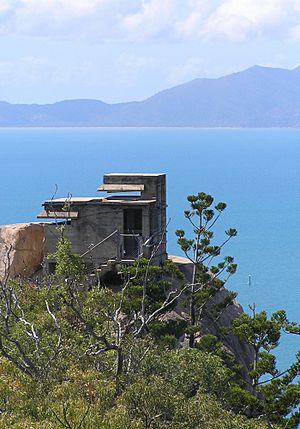Magnetic Battery facts for kids
Quick facts for kids Magnetic Battery |
|
|---|---|
| Magnetic Island, Australia | |

Observation Post overlooking Cleveland Bay, Magnetic Battery
|
|
| Type | Coastal defence installation |
| Site information | |
| Owner | Queensland Parks and Wildlife Service |
| Controlled by | Australia |
| Open to the public |
Yes |
| Site history | |
| Built | 1942-1943 |
| Built by | Queensland Main Roads Commission |
| In use | 1943-1946 |
| Demolished | 1946 |
| Garrison information | |
| Past commanders |
Battery Commander Major Nichol |
The Magnetic Battery, often called The Forts, was a military base on Magnetic Island, Australia. It was built by the Royal Australian Navy during World War II. This important site was located near Horseshoe, Florence, and Arthur Bays.
Construction started in 1942, and the battery was ready by July 1943. It operated until the war ended in 1946. Today, the remains of The Forts are looked after by the Queensland Parks and Wildlife Service. They are part of the Magnetic Island National Park and are open for visitors to explore all year round.
During its operation, the battery had several key parts. These included two searchlights, a radar screen, living quarters for soldiers, and important command and observation posts. It also had two gun placements that overlooked Cleveland Bay. Most of the original buildings are gone, but you can still see the strong concrete structures. These include the command post, observation post, a bunker for ammunition, and the gun placements. You can also find the foundations of many other buildings. These remains are now part of 'The Forts Walk', a popular 3.8 km walking trail for visitors to Magnetic Island.
Contents
Why the Magnetic Battery Was Built
In 1942, the city of Townsville became a very important military base for Australian and American troops. Cleveland Bay, located between Magnetic Island and Townsville, was also a key meeting point. Many supply ships and military boats would gather there before heading out in convoys.
To keep these ships safe from enemy attacks and to help organize them, a large military facility was needed. This is why The Magnetic Battery was built on Magnetic Island. Its main job was to protect the ships and the coastline.
Building The Forts
Construction of the Magnetic Battery began on September 28, 1942. The Queensland Main Roads Commission built the facility following a standard plan for a port war signal station.
First, a road was built from Arcadia to the battery site. This road was important for bringing in materials and supplies. The command post, observation post, and gun placements were carefully hidden. They used local plants, camouflage nets, and even fake rocks made of concrete to blend in with the surroundings.
Most of the building materials arrived by boat at Arcadia. From there, they were transported up the new road to the battery. The strong concrete structures were made with very thick, reinforced concrete. The facility was finished on April 10, 1943, and the Royal Australian Navy quickly began using it. The radar screen in Arthur Bay was operated by the 13th Australian Radar Unit. Major Nichol was the commander of the artillery team, which had over 100 people.
The Guns of Magnetic Battery
The Magnetic Battery had two large guns. These guns were originally meant for Manila but were sent to Magnetic Island instead. They were based on a French design and could be easily moved by a tractor.
Each gun was placed on a concrete base called a Panama mount. This special mount allowed the guns to turn a full 360 degrees. With a long barrel, these powerful guns could fire a heavy shell a very long distance.
After the war ended in 1946, the guns were taken apart and moved away. There is a lot of discussion about whether these guns ever fired a shot in battle. It is known that they never fired at an enemy ship. However, some people believe one gun did fire at an American Navy boat that arrived without warning.
Searchlights and Decommissioning
The Magnetic Battery also had two powerful searchlights. These lights were made by the Sperry Company. They had their own diesel generators at Horseshoe Bay and Florence Bay.
These searchlights were very bright and could spot aircraft from far away. About 20 engineers were in charge of operating these important lights.
After World War II ended, the Magnetic Battery was no longer needed. In 1946, it was officially closed down. The guns were removed, and many of the buildings were taken apart. The remaining materials and equipment were sold to local residents.
The Forts Walk Today
The remains of the Magnetic Battery are now part of a popular walking trail called The Forts Walk. This trail is about 3.8 kilometers long. It follows the path of the original track that led to the battery.
The walk offers amazing views over Arthur and Florence bays. You can often see native wildlife, like koalas, along the path. The Queensland Parks and Wildlife Service looks after the track and the old fortifications. They have built safe staircases to help visitors explore the command post and observation post.
It's important to know that the Command Post building is still used today. It acts as a radio-repeater and a navigation beacon. Because of this, part of the building is closed off to house modern equipment. The Forts Walk is a favorite activity for tourists. A regular bus service takes visitors to the start of the trail.

